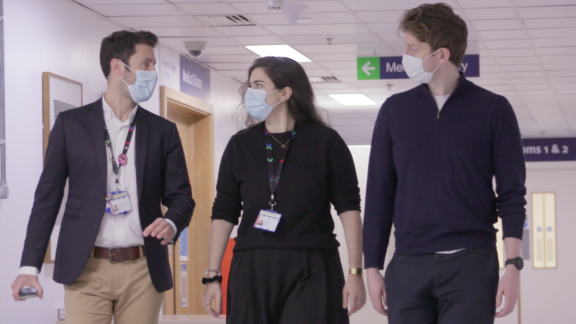Connected systems, integrated care: harnessing the power of data to improve patient outcomes

With increasing collaboration between public health teams, clinicians, and community organisations alike, successful integrated care partnerships must implement data strategies that can make ICS’s objectives a reality, say Tom McArdle and Joanna Peller of Palantir. The potential opportunity - a radical transformation in patient care - is one in which technology partners can play a key role.
Creating conditions for success
To ensure decisions can be made and metrics are tracked across trusts, primary, social, and community care, leaders across the many diverse constituent organisations need to hold a single source of truth.
This is no small endeavour. Achieving a shared understanding of truth will require significant collaboration between leaders across health systems to shape the ways in which clinicians and organisations collect data, as well as consensus on how best to track and share quality and performance metrics. Doing this well will require an ecosystem of partners.
Tracking metrics is only part of the answer. Clinicians and operational managers across primary, acute, social, and community care organisations will need to view full longitudinal patient pathways in near-real time to ensure effective collaboration and take real action to improve patient care. This will require technology investments across an ICS to join up disparate systems along the patient pathway, as no one system can do everything.
As ICSs create new mechanisms for collaboration, they also avoid the centralisation of decision-making process that should be taken closer to the patient. This necessitates the integration of diverse source systems from varied patient administration systems, electronic health records, point of care solutions, workforce, finance and inventory management systems, and much more.
Across an ICS, sensitive data contained in disparate systems must be able to be used by the appropriate decision-makers to make life-saving decisions
Importantly, this will require an architecture that is able to both read and write back to the underlying systems from a data platform that sits above it. These abilities will allow decisions to be executed across a diverse set or organisations and therefore bridge the current decision gaps between disparate organisations and their associated heterogeneity of source systems.
This architecture, and the data within it, must be thoughtfully and securely governed. Across an ICS, sensitive data contained in disparate systems must be able to be used by the appropriate decision-makers to make life-saving decisions. It’s imperative that access to this data is tightly controlled and tracked.
One way of upholding strict governance principles is through the use of Purpose-Based Access Controls. Instead of applying for access to an individual data set, a potential user applies for access to a Purpose. The Purpose is set by data governance teams to contain data specifically scoped to help the user meet their goal — no more, no less. Every user must apply to a Purpose, and they only have access to the data that’s been assigned to that Purpose.
By assigning individuals access to only the subset of data they need … ICS leadership can create a secure and transparent architecture in which patient privacy is paramount
Data governance teams must record a rationale for their decision at the same time they grant a user access to data. Likewise, data owners must record a rationale when they approve the use of a data set for a Purpose. Recording these justifications prompts both sides to continually consider the necessity and proportionality of their decisions. By assigning individuals access to only the subset of data they need, for a defined period of time, and only for documented and legitimate purposes, ICS leadership can create a secure and transparent architecture in which patient privacy is paramount.
Transition to decentralised decision-making
Fortunately, there are other environments in which such a transition of governance from command-and-control to a more dynamic and decentralised decision model has been achieved successfully.
In Chris Ham’s Governing the Health and Care System in England, he relates the shift to an integrated care model to the decentralisation of decision-making within the UK‘s COVID-19 vaccination programme. By building a ’team of teams,’ the NHS was able to empower and operationalise system working. In such an environment, leaders are able to bring together siloed people and processes, streamline communication, and decentralise authority and approval to enable ‘the disciplined practice of empowered execution.’
As the recent COVID-19 vaccination program demonstrated, the NHS has proven itself capable of realising success with such an organisational structure. We were honoured that our software provided the technology backbone to the national vaccination programme and facilitated the distribution of PPE across the NHS during the pandemic. Since then, we have helped the NHS improve the management and coordination of elective waiting lists, theatre scheduling and outpatient management through re-prioritisation and validation, to help those patients fastest who are in greatest need. By connecting EMRs, theatre systems, and annual leave systems, our software has enabled the reduction of waiting lists, supporting clinical prioritisation and improving efficiency. Doctors spend less time with administrative tasks and have more time for direct contact with patients.
Recently, we have started working with ICSs to help them understand emergency demand across their population, support primary care, and identify pressure points with a whole system view.
As we move towards a connected future of integrated care, leveraging technology that meets systems, and people, where they are is pivotal to empowering insight-led execution and improving outcomes. By harmonising information across the care continuum, ICSs will ensure their people, and the decisions they make, can be harnessed in support of their collective ambition: improving outcomes, one patient at a time.
Tom McArdle and Joanna Peller are UK health leads at Palantir. You can follow Palantir on Twitter @PalantirTech
You can learn more about Palantir’s system-wide approach to data governance at NHS ConfedExpo, Liverpool ACC, 15 and 16 June.



